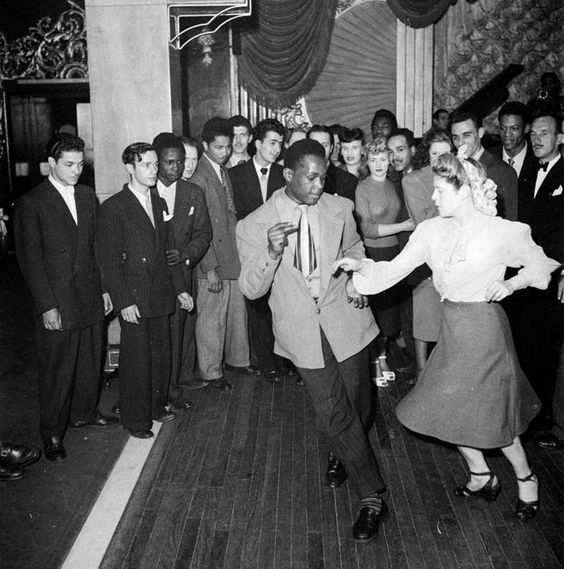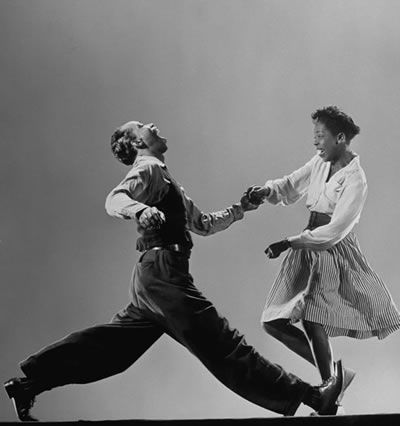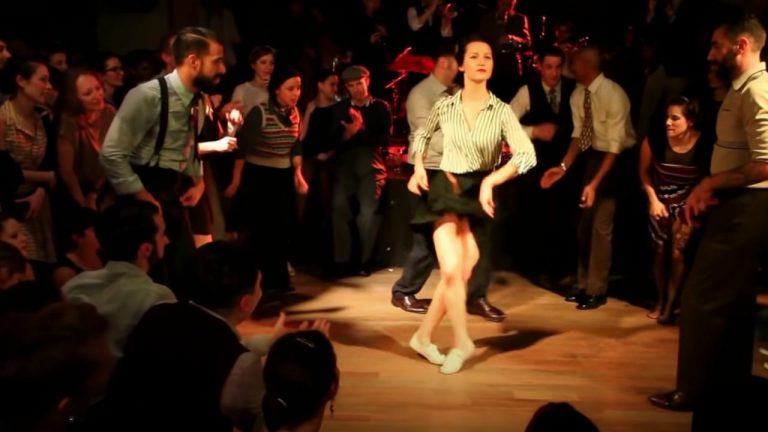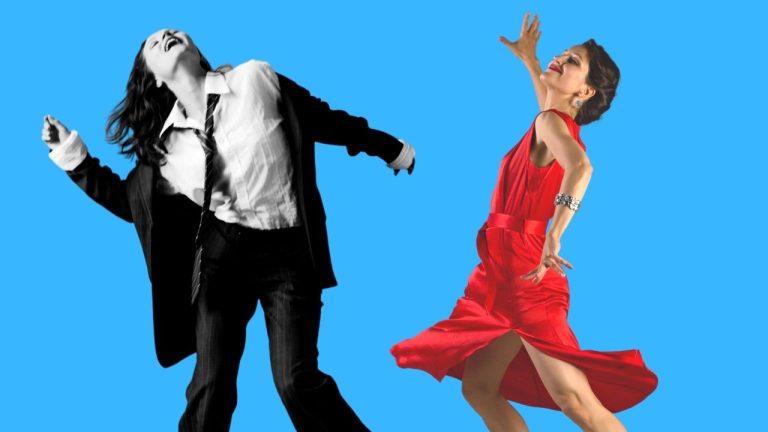Solo jazz is one of the best ways to help you improve your Lindy Hop. Lindy hop is a partnered dance that gives a lot of freedom to each partner. Even when dancing in close position or in a break away or swing out, there is so much freedom to improvise and express the music with your feet.
Every single great Lindy hopper in the old times and now are great solo jazz dancers. No wonder why? One truly can’t be without another.
Have you ever been in the situation where your partner decides to break away for some solo jazz magic, and rather than free, you felt alone, and very unsure? Do you often feel you are out of time, or blame others if you do feel that way? Or maybe you’ve seen a video of yourself afterward a couple dance and realised you may not look quite as elegant as you thought in that moment…then these tips are for you.
1. Want to dance well in couple, learn how to dance solo first
If you are struggling with balance, or, for instance, rotations and turns which is very common, when dancing Lindy hop, consider trying solo jazz. Practice those elements solo first and as a result you will massively improve your Lindy hop. The truth is your partner is not there to help you hold your balance or turn you. Your partner is there to communicate and co -create in a dance together. If you want to improve your Lindy hop, invest in your solo.
In order to learn how to turn, keep balance, and have a good posture you really need to practice those dance elements by yourself first.
When learning Lindy hop we are focusing on leading and following technique. Basically, how does communication in a couple happen, how can one body invite another body into different states and figures. But the essential, fundamental elements of jazz dances, like bounce (pulse), timing, syncopation, footwork, turns and many many more, shall be practiced and learned in solo jazz, and independently of another person which is essential.
When you are confident in those, being in a couple and dancing Lindy hop will feel heavenly.
2. Improve your Lindy Hop by expanding and innovating your footwork
Develop intelligence in your feet. Only you are in charge of your footwork when dancing Lindy hop. Your partner is not going to “inject” variations and lead you for solo steps. You have to work on that part yourself solo. The absolute best way to improve your footwork in Lindy hop is to work on your solo jazz.
What is in your feet is in your feet. If you ever looked at professional Lindy hoppers and dreamed of being so playful and reactive with your feet, do know that it comes from solo jazz dance work. If you know how to do Shorty George and kick ball changes you can add a flavour during the 6 beat passes. Tacky Annies, Apple Jacks, Suzie Qs and scissor kicks can come in very exciting and handy when variating swing out. Lock turns can be a fantastic way to make your turns and under arms passes something spectacular and juicy.
3. Shine at the solo moments
I am sure you once were dancing with (or maybe you yourself is) a playful partner who loves once in a while to let the couple connection go for a moment of solo conversation. And maybe during that moment instead of going for a spotlight move you felt left alone, embarrassed and begging your partner to please come back into the safe shell of the couple…?
In this case, solo jazz is the way to happiness and jazz. Learn a couple of classic vernacular moves like boogie back, boogie front, TOBA break, to know what to do and take the spotlight. Or even learn how to improvise in order to be fully reactive and in the moment respond to the moves of your partner. And if you want to be completely on top of your game, unlock Secrets of improvisation technique to be able to create a few exciting moves or variations and have a call and response conversation with your partner.
So doing, you feel the music, you feel your partner and the two of you, together with the music will create a perfect, balanced triangle.
When you are dancing with your partner, for that two and a half to three minutes, you are in love with each other. You’re corresponding with each other by the moves that you make. It’s a love affair, between you and your partner and the music. You feel the music, you feel your partner, she feels you and she feels the music. So the three of you are together. You’ve got a triangle, you know. Which one do you love best? [Frankie laughs.]
Frankie Manning
4. Variate your Lindy hop moves
The whole point of jazz is improvisation. Once the patterns, basic footwork and figures are in your system, fly away and variate them.
Improvisation and personality are the key points and characteristics of African derived black dances. Jazz is a continuum and its nature is to be continuously evolving with the influences of time and other people. Jazz is a continuous innovation based on strong tradition.
Let’s be honest, that is where the real fun in Lindy hop lies, – in creativity. In order to be creative with your body and footwork mainly, for jazz dances are footwork based dances, we need to learn the principles and the secrets of improvisation and variations. To do that we once again come to the home of solo jazz.
In order to learn how to variate your triple step in swing out, it’s essential to understand what is triple step, how it can be done, what is swinging 8th note and syncopation. Finally, what are the ways and tools to variate a given step! Same goes for rock step, which is as well one of the most common steps in Lindy Hop and swing dances.
It’s this understanding and knowledge which will make a difference and progress. You can learn by doing solo jazz. Eventually, you will be able to dramatically improve your Lindy hop and shine on every single send out and triple step swivel.
If you are specifically interested in Variations, you can check a 4 volume online course “Variation Lab”.
5. Don’t only feel good when doing the Lindy hop, look good
Dance is an aesthetic form. Dance is a combination of feel, time and shapes. And shapes shall be aesthetic. No matter much we emphasise the importance of the feeling when dancing swing dance, dance should as well look good.
Good lines and style don’t only come from feeling good doing a move. That works as well, no doubt. Though, in some situation to get the right feel, you need to copy the shape of the move.
What “good look” means in a dance is an almost philosophical category indeed. Aesthetic does not necessarily mean beautiful. To give an example, the famous choreographer Bob Fosse invented his own signature style with the idea of “ugly movement”. Though he transformed “ugly” into aesthetically beautiful.
However in Lindy Hop the emphasis is mostly on the feeling. The feeling of your partner, lead and follow signals. In some ways you can forget to pay attention to how you are looking when you are dancing. Practicing Solo Jazz we practice the feel and the shape in a holistic way. We do look in the mirror to make sure the shapes are balanced and aesthetic. Working on your moves and shapes solo will significantly improve your Lindy Hop.
6. Find your style
We shall as well talk about the style. To have a style, your own recognisable style, is to be on top of the jazz game. We all have different bodies hence same move will, of course, look different on each one of us.
Unlocking the secrets of your movement and bringing out your own style can be a long process. But it’s a journey for a treasure worth taking. You can spend some time researching your body, your movement solo in front of the mirror or camera. Ask yourself what are your strengths? What exactly makes your movement yours?
Jean Veloz swivels are so distinctive. You can recognise her angular shapes with loads of shoulder and hip movement and upright posture.
And now look at Jewel McGowan with her fabulous extreme knee swivels and the arm behind.
One more interesting female Lindy Hopper Genevieve Grazis (Jenny Grey) P.S. Don’t mind the clap on 1.
Look at The Ambassador of the Lindy Hop, Frankie Manning and Willa Mae Ricker. The style is called Savoy Style. Low, fast and fierce. Frankie was the innovator and a creator of an acrobatics in Lindy. You can see he is bowing so low to his dance partner on the breakaway moments, when doing the kick back.
And here is Dean Collins with Bertha Lee gliding. Dean Collins has this impatience in his footwork. It’s fast and energetic. Though the upper body stays “concentrated”, almost bracing. You can see he is doing his signature turn in the solo moments.
7. Develop a body awareness
Practicing solo jazz helps you develop a body awareness and consciousness that is often not trained in Lindy hop classes. In a general Lindy Hop dance class you may focus more on connection, new moves to learn with your partner or just social dancing. In solo jazz, because of its individual nature, you really focus on yourself.
You are the only responsible for your feelings and aesthetic in your solo dance. You feel bad at improvising? Then start again, go through solo jazz vocabulary. Play some games to make the process more enjoyable (check out Ksenia’s Method “practice games”) Look at yourself in the mirror and try to improve what you don’t like. A step a day, and it will get better
8. Develop your sense of confidence
Quite often in partner dance we are dependent on the other person to dance with us. Hence if we have great timing and they don’t you can try to help them, even though it can feel uncomfortable. Equally if you have bad timing and your partner is amazing, they can guide you, and so you become dependent on their timing. You then switch to another dancer, who doesn’t have such good timing and now you are both lost.
Before we go blaming the other dancer, thinking it must be their fault. To dance well with dancers x,y,z, it is important we know our own timing is solid, balance is good and footwork is clean. Yet again solo jazz dance will show you this, in an instant! There is no one to blame, no one else to look at but yourself .
Try to increase your confidence starting from learning how to solo dance, you will see how much better you feel while dancing in a couple.
If you would like my help with some of these tips and put them into practice, visit my online dance school Secrets of Solo. You can check subscription plans here.




